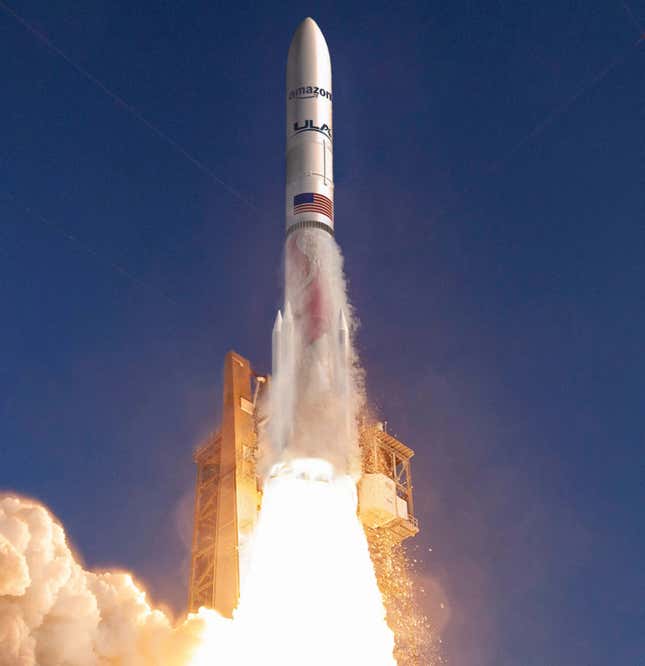The Bezos-Musk rivalry intensifies this week as Amazon gears up for the launch of two demo internet satellites. This marks the beginning of the Amazon billionaire’s 3,236-satellite-strong megaconstellation that might one day compete with Musk’s leading space-based service, SpaceX—with “one day” being the operative phrase.
Amazon’s space initiative, Project Kuiper, is scheduled to launch its first two satellites, KuiperSat-1 and KuiperSat-2, on Friday, October 6. The scheduled event will take place at Cape Canaveral Space Force Station in Florida, with the demo satellites riding aboard United Launch Alliance’s (ULA) Atlas V rocket. The launch window for the mission opens at 2:00 p.m. ET under an 80% favorable weather forecast, according to an emailed ULA statement.
Related article: What’s the Difference Between SpaceX’s Starlink and OneWeb?
The upcoming mission, dubbed Protoflight, is crucial, as it signifies Amazon’s entrance into the satellite broadband market, a space primarily occupied by SpaceX’s Starlink and London-based OneWeb. According to stats kept by Jonathan McDowell of Harvard-Smithsonian, SpaceX currently boasts 4,812 working Starlink satellites, with OneWeb operating 632 satellites in orbit. While Starlink focuses on direct consumer services, OneWeb primarily caters to internet service providers.
Advertisement
Kuiper’s hybrid service model
Amazon’s Project Kuiper, which kicked off its research and development phase in 2018, is poised to be a bit like both; the company plans to provide both small customer terminals and a ground-based communications network. Vodafone and its African branch, Vodacom, have partnered with Amazon to use Project Kuiper to expand their 4G/5G networks. This new collaboration, announced in September, mirrors Amazon’s 2021 deal with Verizon to enhance telecom services in the United States.
Advertisement

Similar to claims made by SpaceX and OneWeb, Kuiper satellites promise to “bridge the digital divide by providing fast, affordable broadband to communities unserved or underserved by traditional communications technologies,” according to Amazon.
Advertisement
The chance to finally test Kuiper in space
In a press release, Rajeev Badyal, Project Kuiper’s vice president of technology, said: “We’ve done extensive testing here in our lab and have a high degree of confidence in our satellite design, but there’s no substitute for on-orbit testing,” he said, adding that “we’re going to learn an incredible amount regardless of how the mission unfolds.”
Advertisement
The plan is for Atlas V to deploy the two satellites at an altitude of 311 miles (500 kilometers). Amazon’s teams will be on standby, awaiting first contact with the satellites, ensuring their solar arrays deploy for power, and monitoring onboard electronics in the challenging environment of space. The demo mission aims to validate the entire Project Kuiper system; engineers plan to test ground components to ensure uninterrupted communication between satellites, ground stations, the Kuiper System, and AWS.
“As the mission progresses, we will test the network from end to end, sending data back and forth between the internet, our ground gateways, the satellites, and our customer terminals,” writes Amazon.
Advertisement
At the mission’s conclusion, Amazon plans to safely deorbit both satellites, allowing them to burn up in Earth’s atmosphere. Indeed, Amazon claims it has meticulously designed its satellites with space safety in mind, with provisions to prevent in-orbit collisions with other objects or satellites in low Earth orbit. As to the constellation’s eventual influence on astronomy, that remains an open question. Astronomers have repeatedly sounded the alarm over satellite megaconstellations, arguing that they threaten our ability to observe the cosmos.
The clock is ticking for Amazon
The company is operating under a tight timeline, with a Federal Communications Commission (FCC) license stipulating the deployment of half of its satellite constellation by July 2026. Despite initial challenges, including a switch from ABL Space Systems’ RS1 rocket to ULA due to developmental delays, Amazon claims to be on track. The company anticipates serving its earliest Project Kuiper customers by the end of 2024, even though the full satellite deployment might stretch until 2029. The company has secured 77 heavy-lift launches with commercial launch providers, including Arianespace, ULA, and Bezos’s own Blue Origin (technically, Project Kuiper and Blue Origin are separate entities, but potential collaborations between the two are likely, for better or worse).
Advertisement
The Bezos versus Musk space showdown is heating up with Amazon’s latest moves, but we need to be real. Even with Bezos’s cosmological ambitions, Musk’s SpaceX remains way ahead. And there are other players (e.g., Viasat and HughesNet) in the mix to use space as a place to broadcast broadband internet. For now, it seems Bezos is still playing catch-up in the space race, but you gotta start somewhere.
For more spaceflight in your life, follow us on X (formerly Twitter) and bookmark Gizmodo’s dedicated Spaceflight page.
Services Marketplace – Listings, Bookings & Reviews